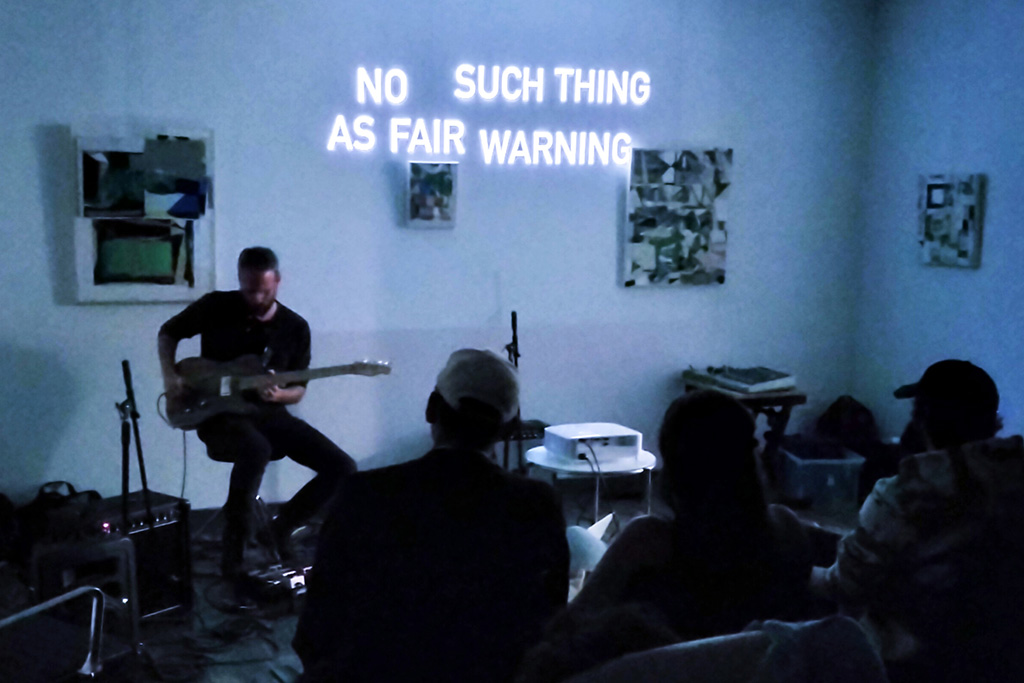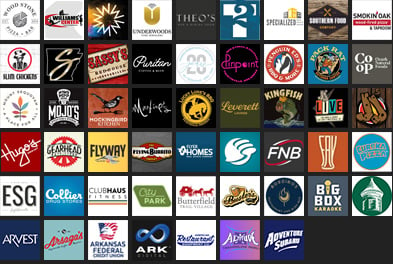 Untight, an improvisation-driven sound art project by artist and musician Sam King (Courtesy photo)
Untight, an improvisation-driven sound art project by artist and musician Sam King (Courtesy photo)Untight is a microtonal guitar and effects project from musician and painter Sam King. If you’re a live music enthusiast you’ve probably caught him in one of the many bands he’s played in or experienced a show he’s put together via Fayetteville’s DIY space Lalaland, which he co-ran for many years. Named an album of note by Stereogum, he’s just released Fair, a live recording rich with sonic images of grief, dread and bliss. We caught up with him ahead of his album release show, coming up May 30 at The Creamery (216 W. Birch in Rogers), to discuss his custom built guitar, what he seeks out in live music venues and why he’s drawn to improvisation.
You play a custom built guitar. Tell us more about what drew you to building it and why. And more about the instrument itself.
I’ve been treating electric guitars like Legos for years. At first, it was to create third bridge effects. I bought a Yamaha stratocaster copy at a flea market for $65. I have reworked and repurposed that guitar so many times, literally all I have left of it is the bridge. I got the idea from Netherlands-based experimental luthier Yuri Landman, who I found on social media many years ago. Also, Lewis Waters, who works in Australia under the name New Complexity, makes instruments in this vein.
In reading about the mechanics of sympathetic resonance (what creates the third bridge effect), I learned that most harmonic relationships on a guitar are only approximations. I became curious about what it would be like to have the intervals associated with the natural harmonic series accessible on a guitar’s fretboard. Making a guitar neck from scratch is beyond my skill set, so a few years ago, I started looking for people who could do what I had in mind. I connected with an instrument builder in Maryland named John Jansen, who was interested in the work. I wound up with a 29.5” scale baritone electric guitar that has both standard frets (12-tone equal temperament) and additional frets corresponding to the natural harmonic series (just intonation). I asked John to color code the frets, so I don’t get confused.

Experimental Expansions
What: Album release show for Untight
When: 7:30 p.m. Thursday, May 30
Where: The Creamery, 216 W. Birch St. in Rogers.
Info: trilliumsalonseries.com
Composer La Monte Young and his work The Well-Tuned piano are deeply influential for Untight. When did you first come across the work and what was that experience like?
I ran across The Well-Tuned Piano in my online searches for more information on harmony and intonation. This was probably around 2011 or so. The University of Arkansas library has a copy of the 1987 vinyl release. I checked it out and listened to it on my record player at home, which felt pretty special, particularly if you’ve ever gone looking for it on Discogs.
It’s a long-form (6+ hours) improvisational work with a wide dynamic range, including multiple passages with big clouds of sound. Young developed a technique specifically for the effect, stacking both hands over the same keys. The piano’s tuning is profoundly different to what we typically hear in the west, but it’s also mathematically elegant. It’s based on relationships of pure fifths and sevenths. Some of the intervals are so close, the notes beat against each other, creating a buzzing, shimmering effect, which is magnified by that fluttering attack on the keyboard. I wanted to find a way to make a guitar do something like this. I use delay and loop effects.
You used to co-run the DIY space Lalaland, which hosted tons of shows. How does the DIY spirit influence Untight?
I like it when art conveys the sense of being both possible and desirable to do. DIY scenes can be a good space for this. You see the pieces fitting together, see yourself doing it, and then, suddenly, you are.
The first time I played a set as Untight was at the venue’s last show. For eight years or so, there was a real embodiment of an idea or feeling that my friends and I shared—a physical space you could walk into. When it ended, I realized I have to carry that thing with me. It won’t always be a place. This music is one way that I do that.
You’re also a painter. Visuals come into play in Untight because you perform with projected words. This release also included limited edition cassettes with individually hand-drawn covers. Tell us more about the intersection between sound and visuals.
Pitch and color are each a kind of wavelength. The composer and instrument-builder Harry Partch used color as a metaphor to explain why he wanted to divide the octave into 43 notes, instead of 12. There is tremendous communicative power in small nuances of pitch.
The drawings I made for the cassette inserts are part of a series that started while I was at the Hambidge Center a few years ago. I was there to work on music, but one day these little gem-like forms just kind of showed up, and I’ve drawn them ever since. I think of them as diamonds, which connects them both to Arkansas and to the phenomenon of manufactured scarcity.
This music is pretty meditative, so it helps to have something to do with your eyes. The text projections are an extension of what I’m doing with the music: creating continuities, frictions, ambiguities, and possibilities. I guess it’s also a way for instrumental music to have lyrics.
The Creamery is a distinct acoustical space! Describe it and what you’re excited about for the performance coming up.
The Creamery feels like Lalaland did, to me. I like that about it. The high ceilings make for rich echoes. I recorded States, the release just before Fair, at The Tank Center for Sonic Arts, in Rangely, CO. It’s a decommissioned water silo with a recording studio attached. The reverberation there is truly incredible. States itself did the opposite of reverberate—it fell down the well of Covid. I encourage the reader to give it a listen, along with Fair. It’s the most personally significant creative thing I did during the most intense months of the pandemic.
You’ve performed in a lot of bands and musical projects over the years. You’re also in Big Drama, a post-punk duo that debuted its first show at Smoke & Barrel Tavern in February. What are some early musical memories and what drew you into being a musician to begin with?
I grew up hearing The Beatles, Joni Mitchell, Al Green, Neil Young, Steely Dan, Michael Jackson, The Supremes, Antonio Carlos Jobim, Django Reinhardt and Stephane Grappelli, and Ry Cooder, among lots of others. There were two copies of Jimi Hendrix’s Are You Experienced? in the house, because my parents both had it before they got married.
My dad plays guitar and has written many songs over the years. I think he could have been a teacher. There is some specific thing he told me to listen for in the music of pretty much everyone I just mentioned—like the restraint in the arrangements of Al Green’s songs. His repertoire crosses genres, sometimes even centuries. He’s a rhythm guitarist, more than lead, and is quite thoughtful about his chord phrasings. I can hear his influence in my brother Will’s playing. The bossa nova-esque sound in some Sad Palomino songs is a nod to our dad.
I started learning the guitar around 13 or so. It’s always been very personal, driven by intuition, friendship, and the desire to create. Both my brothers had more formal training in music. I took a year or two of piano and violin when I was still in grade school, but I ended up pursuing art as an academic discipline. So many ideas and values transfer between creative fields, though. A lot of my friends tend to be invested in more than one—like Stephanie Pierce, a great painter who used to live here and who co-founded Lalaland.
When I was first playing guitar, I liked Nirvana a lot. I remember noticing that Kurt Cobain’s tendency to play barre chords by flattening out his ring finger over multiple strings meant he often got a sus4 chord instead of a basic fifth chord. It’s a bit of “bad technique” that made the songs richer. I listened to other radio rock, too, that hasn’t held up as well for me. It’s weird walking into stores and restaurants with 90s playlists on their sound systems. It might have sounded like liberation, then, but a lot of it hits more like a TV commercial now.
When I was in high school, there was a punk club called Ravi’s on Towson Avenue in Fort Smith, AR. I saw lots of bands there, both touring and local. Some of the best musicians I’ve ever seen played there, and they were local. Some still are, and I’m so grateful that I’ve gotten to know them over the years. Through friends, I found out about The Minutemen, Fugazi, Bad Brains, Sonic Youth, Pixies, Tortoise, and lots of other bands that formed me as a guitarist and bassist.
We’d also drive up to Fayetteville to go to shows at Clunk Music Hall. I went to college in Tulsa, and we would make the drive from there, too, for Clunk’s shows. This was when bands like Modest Mouse and The Dismemberment Plan were playing through. I know I’m not the only person whose life was really impacted by the world that Chris Selby (Clunk) made, back then, as well as Jason Garvey and Jon Panikkar, who ran Ravi’s. It was so vital and fun, and a window into what was possible in life. I still prefer art and music that have at least a hint of that sensation. Everything else just feels like business.

